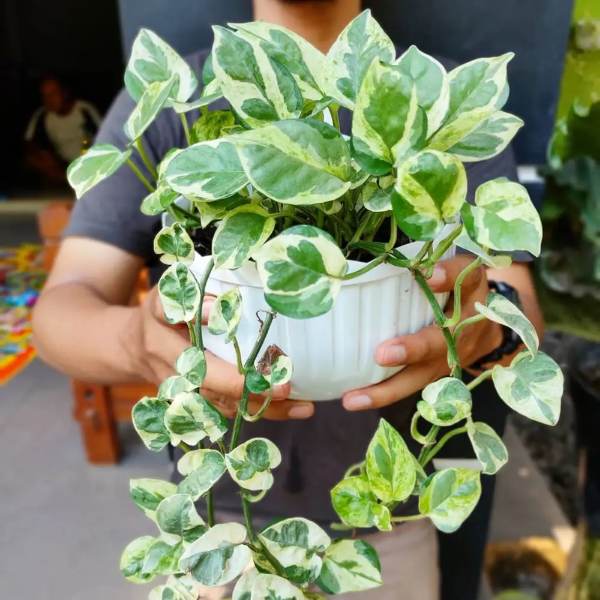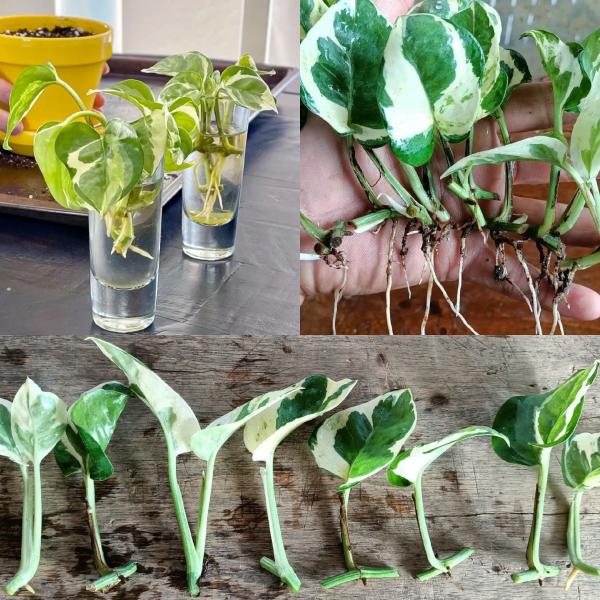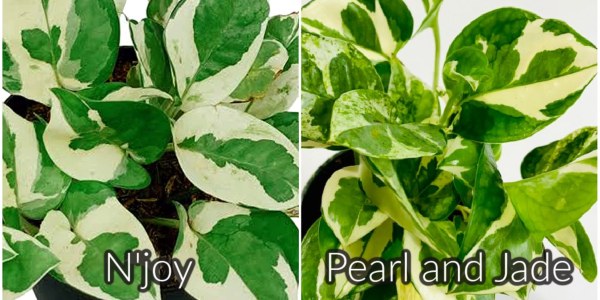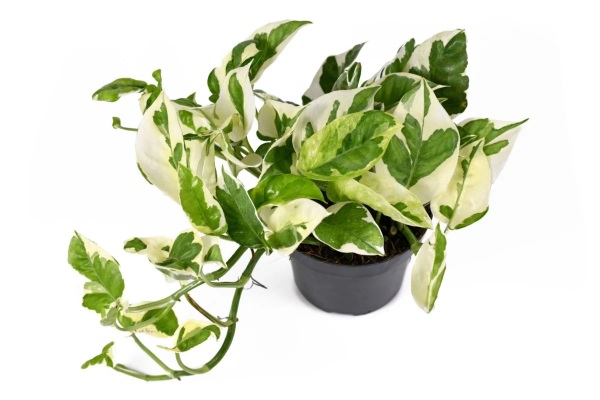N’Joy Pothos is one of the varieties of pothos that may be used in indoor and outdoor areas. This versatile houseplant became popular because it helps purify the air. N’Joy Pothos has vibrant, heart-shaped leaves that are adorned with striking green and white variegation. Furthermore, N’Joy is a highly resilient and low-maintenance plant, suitable for both beginners and professionals.
Below, we will discuss everything you need to know about N’Joy Pothos from tips and benefits to pricing and where you can get one.
Overview
Plant Type: Perennial, Vine
Season: Spring, Summer
Family: Araceae
Genus: Epipremnum
Species: Epipremunum aureum
Scientific Name: Epipremnum aureum N’Joy
Common Name: Pothos, Devil’s Ivy, Pothos N’Joy, N’Joy Pothos
Native Area: Asia
Toxicity: Toxic to pets
Introduction to N’Joy Pothos: Scientific Name and Classification

The scientific name of N’Joy Pothos is Epipremnum aureum N’Joy. However, it is also commonly referred to as Devil’s Ivy, Pothos N’ Joy, or simply N’Joy Pothos. It belongs to the Araceae family. N’Joy is well known for its unique variegated heart-shaped leaves with cream and green patterns. Similar to other pothos, it is an easy, low-maintenance houseplant suitable for hanging baskets, tabletop planters, or simply trailing down a shelf or bookcase. Further, just like other pothos plants, N’Joy Pothos is toxic to pets if ingested, so it is important to keep it away from the reach of curious pets.
Understanding N’Joy Pothos Size and Growth Patterns
Size
N’Joy Pothos are trailing plants, excellent for hanging containers, and simply catch attention with their bright foliage. In their native habitat, pothos can grow vines up to 40 feet, but indoors, they typically reach 6 to 10 feet, though they can be trained longer. Similarly, indoor leaves are usually 4 to 8 inches long, compared to 3 feet in the wild. Pothos vines can hang or climb, making them versatile for decoration.
Growth Patterns
Most Pothos grow moderately to fast, especially in warmer temperatures, but growth slows in winter. It also grows more slowly in low light and faster in brighter light. They can grow several feet in a season under optimal conditions, influenced by light, water, temperature, and fertilization. Well, Pothos N’Joy grows slower than Golden or Neon Pothos.
Essential Care Tips for N’Joy Pothos
Light
Since Pothos N’Joy has variegated leaves, it needs a brighter light than the solid green Pothos to maintain leaf brightness. It grows best in medium to bright light, especially in very bright indirect light. However, you may avoid direct sunlight, as it can burn the leaves.
Soil and Water
It does best in light, loose, well-draining soil that will end up holding a bit of moisture. It likes its soil to go a bit dry between rounds of watering. Let the top 2 to 3 inches of the soil dry before you finally reach for the watering can and let some of the extra water come out of the bottom of this plant. Be careful not to overwater, since these plants can rot if the soil stays too wet.
Temperature and Humidity
Pothos grow naturally in shade and the humid atmosphere of the rainforest, but they will do quite well in normal interior environments. This plant prefers temperatures of at least 65 °F and humidity should be between 50 to 70%. If your home is too dry, feel free to put this in a naturally humid space, like in the bathroom, or stick by the plant with a small humidifier for optimal conditions

Fertilizing
During the growing season, N’Joy does require frequent fertilization to promote strong and healthy growth. Similarly, a balanced liquid fertilizer should applied once a month from spring to summer but avoided during fall and winter.
Pruning and Repotting
Though this plant requires no pruning, you can prune it during the spring and summer seasons. It helps in managing its growth and shape. N’Joy pothos grows slowly so, trimmed parts will not grow back that fast.
Pest Control
Like many houseplants, this beautiful plant can be infested with common pests or develop common diseases. Common houseplant pests such as fungus gnats, spider mites, mealybugs, and thrips are attracted to this plant. So it is important to regularly inspect your plant. If your plant already has the infestation, you may immediately isolate the plant and trim down the affected leaves. You can further use systemic pesticides.
The Benefits of Growing N’Joy Pothos
- N’Joy Pothos is a highly effective air purifier plant.
- Growing N’Joy in your surroundings helps remove many of the common household toxins from the air.
- This pant is a very durable plant that does well under low-light conditions.
- Similarly, its variegated white and green leaves absorb carbon dioxide and can produce oxygen at a slower rate compared to other Pothos varieties.
N’Joy Pothos propagation Methods
To grow new Pothos N’Joy plants, you can cut off a small piece of the stem with a few leaves or a single node less than 6 inches long. Then, you can put the stem in a clear plastic container with water or damp moss. The plant will have to be kept warm at about 77°F, adding some rooting hormones to stimulate the forming of roots. Further, it required natural light but not direct sunlight.
N’Joy Pothos Price and Availability
You can find N’Joy Pothos in most garden centers and plant nurseries, or even more so in online stores. However, the price will vary according to the size and age of the plant. Younger plants or cuttings are very cheap, which will cost $5 to $15. On the other hand, bigger plants or hanging baskets of older plants cost between $20 to $40 or more. Furthermore, you can contact local shop owners or online shops in your area to get more information about this beautiful indoor plant.
Key Differences Between N’Joy and Pearls and Jade Pothos

N’Joy and Pearls and Jade are both popular varieties of the Epipremnum aureum, commonly referred to as pothos. Even though they resemble each other, there is a big difference between them when it comes to their appearance, growth habits, and care requirements.
Appearance
N’Joy Pothos: This plant has distinctive physical characteristics that set it apart from Pearls and Jade. Typically, its leaves are found to have a whitish color in the backdrop, with a greenish splash or shades in between. Similarly, it has glossy heart-shaped leaves with a leather-like texture.
Pearls and Jade: On the other hand, pearls and jade plants have varied color variegation like pf green, cream, and white. Its leaves have a mix of green and cream color with grey color spots in between. The leaves of pearls and jade plants have crispy-like paper pointed with a narrow-angel shape.
Growth Habit
N’Joy Pothos: As we already mentioned above, it does grow more slowly than many other varieties of pothos. This plant has a compact, bushy growth habit but can start to vine as it matures.
Pearls and Jade: Pearls and Jade grow slightly faster than that of N’Joy, but are still slower than non-variegated pothos varieties. They grow either trailing or in vine form, so they will do well in hanging baskets or on climbing supports. If you place the plant on the ground with some kind of supporting structure, such as a moss pole or trellis, they will cling to it, and grow up, showcasing their beautiful variegated foliage.
Care Requirements
N’Joy Pothos: This plant requires bright, indirect light to maintain its variegation. It needs watering, however, allow the top inch of soil to dry out between waterings. Similarly, make sure that the plant does not become soggy. It can tolerate average household humidity in well-draining, aerated soil.
Pearls and Jade: It needs the same care as N’Joy Pothos, but it might not handle low light compared to N’Joy Pothos.
Also read, The 20 Best, Easiest Houseplants That Can Be Grown in Any Home!
Frequently Asked Questions
1. Is Pothos N’Joy rare?
Yes, Pothos N’Joy are rare plants.
2. Do N’Joy pothos need sunlight?
Yes, since Pothos N’Joy has variegated leaves, it needs a brighter light than the solid green Pothos to maintain leaf brightness. It grows best in medium to bright light, especially in very bright indirect light. However, you may avoid direct sunlight, as it can burn the leaves.
3. What is the difference between N’Joy and Pearls and Jade Pothos?
The leaves of the N’joy pothos plant have a whitish color in the backdrop and a greenish splash or shades in between, while Pearls and Jade have more intricate variegation with pf green, cream, and white. Pearls and Jade grow slightly faster than that of N’Joy and might not handle low light as well.
